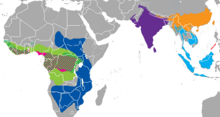Manidae
| Manidae | |
|---|---|

| |
| Living speacies of pangolins | |
| Scientific classification | |
| Kingdom: | Animalia |
| Phylum: | Chordata |
| Class: | Mammalia |
| Clade: | Pholidotamorpha |
| Order: | Pholidota |
| Suborder: | Eupholidota |
| Superfamily: | Manoidea |
| Family: | Manidae Gray, 1821[2] |
| Type genus | |
| Manis | |
| Genera | |
| |

| |
Species ranges:
| |
| Synonyms | |
|
list of synonyms:
| |
Manidae is the only extant family of pangolins from superfamily Manoidea.[5] This family comprises three genera (Manis from subfamily Maninae, Phataginus from subfamily Phatagininae, and Smutsia from subfamily Smutsiinae),[1] as well as extinct Fayum pangolin.[6]
Classification and phylogeny[]
History of classification[]
All species of living pangolin had been assigned to the genus Manis until the late 2000s, when research prompted the splitting of extant pangolins into three genera: Manis, Phataginus, and Smutsia.[5][7]
Taxonomy[]
- Family: Manidae (pangolins)
- Subfamily: Maninae (Gray, 1821)
- Genus: Manis (Linnaeus, 1758) (Asiatic pangolins)
- Manis crassicaudata (Gray, 1827) (Indian pangolin)
- Manis pentadactyla (Linnaeus, 1758) (Chinese pangolin)
- † (Kormos, 1934)
- † (Dubois, 1908)
- Subgenus: Paramanis (Pocock, 1924)
- Manis javanica (Desmarest, 1822) (Sunda pangolin)
- Manis culionensis (de Elera, 1895) (Philippine pangolin)
- †Manis palaeojavanica (Dubois, 1907) (giant asian pangolin)
- Genus: Manis (Linnaeus, 1758) (Asiatic pangolins)
- Subfamily: Phatagininae (Gaubert, 2017) (small African pangolins)
- Genus: Phataginus (Rafinesque, 1821) (African tree pangolins)
- Phataginus tetradactyla (Linnaeus, 1766) (long-tailed pangolin)
- Phataginus tricuspis (Rafinesque, 1821) (tree pangolin)
- Genus: Phataginus (Rafinesque, 1821) (African tree pangolins)
- Subfamily: Smutsiinae (Gray, 1873) (large African pangolins)
- Genus: Smutsia (Gray, 1865) (African ground pangolins)
- Smutsia gigantea (Illiger, 1815) (giant pangolin)
- Smutsia temmincki (Smuts, 1832) (ground pangolin)
- † (Terhune, 2021)[8]
- Genus: Smutsia (Gray, 1865) (African ground pangolins)
- Incertae sedis
- †Manidae sp. [DPC 3972 and DPC 4364] (Gebo & Rasmussen, 1985) (Fayum pangolin)
- Subfamily: Maninae (Gray, 1821)
Phylogeny[]
Phylogenetic position of family Manidae within superfamily Manoidea.[5][7][9][10][1]
| Pholidotamorpha |
| |||||||||||||||||||||||||||||||||||||||||||||||||||||||||||||||||||||||||||||||||||||||||||||||||||||||||||||||||||||
(Pholidota sensu lato)
|
References[]
- ^ a b c Philippe Gaubert, Agostinho Antunes, Hao Meng, Lin Miao, Stéphane Peigné, Fabienne Justy, Flobert Njiokou, Sylvain Dufour, Emmanuel Danquah, Jayanthi Alahakoon, Erik Verheyen, William T Stanley, Stephen J O’Brien, Warren E Johnson, Shu-Jin Luo (2018) "The Complete Phylogeny of Pangolins: Scaling Up Resources for the Molecular Tracing of the Most Trafficked Mammals on Earth" Journal of Heredity, Volume 109, Issue 4, Pages 347–359
- ^ J. E. Gray. (1821.) "On the natural arrangement of vertebrose animals." The London Medical Repository Monthly Journal and Review 15:296-310
- ^ "The CITES Appendices". Convention on International Trade in Endangered Species of Wild Fauna and Flora. CITES. Retrieved 28 January 2019.
- ^ J. E. Gray. (1825.) "An outline of an attempt at the disposition of Mammalia into Tribes and Families, with a list of genera apparently appertaining to each Tribe." Annals of Philosophy, new series 10:337-344
- ^ a b c Gaudin, Timothy (2009). "The Phylogeny of Living and Extinct Pangolins (Mammalia, Pholidota) and Associated Taxa: A Morphology Based Analysis" (PDF). Journal of Mammalian Evolution. Heidelberg, Germany: Springer Science+Business Media. 16 (4): 235–305. doi:10.1007/s10914-009-9119-9. S2CID 1773698.
- ^ Daniel Gebo, D. Tab Rasmussen (1985.) "The Earliest Fossil Pangolin (Pholidota: Manidae) from Africa" Journal of Mammalogy 66(3):538
- ^ a b Kondrashov, Peter; Agadjanian, Alexandre K. (2012). "A nearly complete skeleton of Ernanodon (Mammalia, Palaeanodonta) from Mongolia: morphofunctional analysis". Journal of Vertebrate Paleontology. 32 (5): 983–1001. doi:10.1080/02724634.2012.694319. ISSN 0272-4634. S2CID 86059673.
- ^ Terhune, C. E.; Gaudin, T.; Curran, S.; Petculescu, A. (2021). "The youngest pangolin (Mammalia, Pholidota) from Europe". Journal of Vertebrate Paleontology. in press: e1990075. doi:10.1080/02724634.2021.1990075. S2CID 245394367.
- ^ Du Toit, Z.; Grobler, J. P.; Kotzé, A.; Jansen, R.; Brettschneider, H.; Dalton, D. L. (2014). "The complete mitochondrial genome of Temminck's ground pangolin (Smutsia temminckii; Smuts, 1832) and phylogenetic position of the Pholidota (Weber, 1904)". Gene. 551 (1): 49–54. doi:10.1016/j.gene.2014.08.040. PMID 25158133.
- ^ du Toit, Z.; du Plessis, M.; Dalton, D. L.; Jansen, R.; Paul Grobler, J.; Kotzé, A. (2017). "Mitochondrial genomes of African pangolins and insights into evolutionary patterns and phylogeny of the family Manidae". BMC Genomics. 18 (1): 746. doi:10.1186/s12864-017-4140-5. PMC 5609056. PMID 28934931.
External links[]
- ZSL Pangolin Conservation
- Pangolin: Wildlife summary from the African Wildlife Foundation
- Tree of Life of Pholidota
- National Geographic video of a pangolin
- Proceedings of the Workshop on Trade and Conservation of Pangolins Native to South and Southeast Asia (PDF)
- The Phylogeny of Living and Extinct Pangolins (Mammalia, Pholidota) and Associated Taxa: A Morphology Based Analysis (PDF)
- Bromley, Victoria (Director/Producer), Young, Nora (Narrator/Host), Diekmann, Maria (2018). Nature: The World's Most Wanted Animal. United States: PBS.
- Coronavirus: Revenge of the Pangolins? The New York Times, March 6, 2020.
Categories:
- Pangolins
- Mammal families
- Taxa named by John Edward Gray
- Mammal stubs




